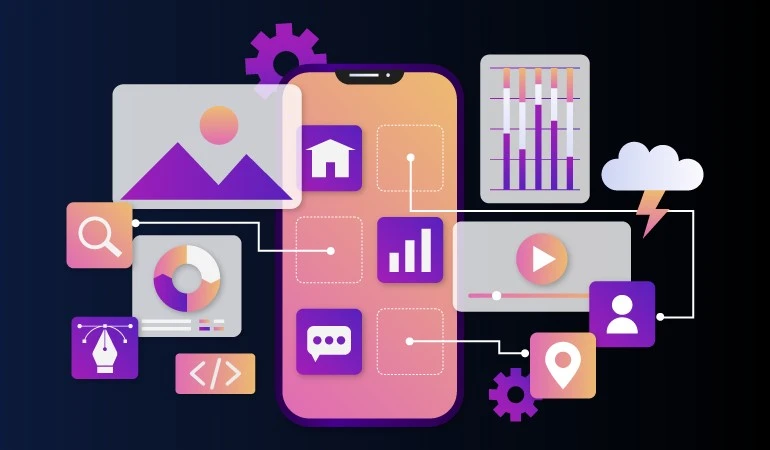
Users want responsive, efficient, and high-performing applications that deliver a good user experience (UX). However, ensuring that your application is efficient requires work on the developer’s part. One way to ensure a responsive Flutter application development service is to perform background tasks. These tasks enable your app to maintain responsiveness and handle tasks that don’t require immediate user interaction. Flutter run function in background assess the responsiveness of your apps.
Flutter provides various mechanisms to accomplish background processing. In this blog, we’ll explore several methods for running background tasks in Flutter, along with which background task works best for a given purpose. The agenda also covers the impact of Flutter run function in background. Moreover, there will be a detailed discussion over background service in Flutter, Flutter run in background, Flutter background tasks, and Flutter background service.
Isolates in Flutter
Flutter uses isolates, which are separate threads of execution, to perform background tasks without blocking the main UI thread. Each isolate in Flutter app development runs in its own memory space and communicates with the main UI thread using messages. Flutter run function in background helps keep the app responsive even during resource-intensive operations.
Key Points in Flutter Isolates
- Concurrency and Parallelism: Concurrency refers to the ability of a system to handle multiple tasks concurrently. Isolates allow you to run tasks concurrently, but they don’t necessarily execute in parallel by default. Parallelism involves running multiple tasks simultaneously on different CPU cores, and Flutter isolates can potentially achieve parallelism on devices with multiple cores. The same theory applies to Flutter run function in background.
- Isolate Communication: Isolates do not share memory space with the main UI thread or other isolates. To communicate between isolates, you use message passing. Flutter provides the SendPort and ReceivePort classes to send and receive messages between isolates.
- compute() Function: To simplify working with isolates, Flutter provides the compute() function. It takes a function and input arguments, runs the function in a separate isolate, and returns a Future with the result. This abstraction makes it easier to offload tasks to isolates without directly dealing with Isolate.spawn() and ReceivePort. Flutter run function in background simplifies task offloading.
- Isolate Lifespan: Isolates are independent entities with their own lifecycle. They are spawned when needed and terminated when their work is done or when explicitly killed. If you kill an isolate, it may cannot restart. They are important to Flutter background.
- Dart Isolates vs. Android/iOS Threads: Dart programming language isolates are similar in concept to threads on Android or iOS, but they are more lightweight. While native threads come with significant overheads and can be expensive to create, Dart isolates are less expensive to spawn and have a minimal memory footprint.
- Use Cases for Isolates: Isolates are suitable for tasks that require significant computation or might cause the app to freeze or become unresponsive if run on the main UI thread. Common use cases include heavy data processing, encryption/decryption, image manipulation, database operations, and network requests.
Example of Using the compute() function in a separate isolate
// Task to be performed in the isolate
void _performTask() {
//perform a task
}
// Using compute to run the task in a separate isolate
Future<void> performBackgroundTask() async {
await compute(_performTask);
}
Moreover, Isolates is a popular concept in Flutter background process. When using isolates or Flutter run function in background, it’s essential to consider the overhead of message passing and avoid sending large objects between isolates, as it can affect performance. Instead, prefer to send only the necessary data and use the result returned from the isolate’s computation.
In any case, Flutter isolates are a powerful tool to improve the performance and responsiveness of your Flutter applications by distributing tasks that would otherwise block the main UI thread. Additionally, Flutter background assists isolates. Understanding isolates in Flutter app development and Flutter run function in background services can help you optimize your app’s performance and deliver a smoother user experience.
Background Fetch in Flutter
For tasks that need to be executed periodically, even when the app is in the background or terminated, you can use the ‘background_fetch’ package. This package allows you to schedule background fetch events and perform tasks during those events. Keep in mind that the frequency of background fetch execution or Flutter run function in background depends on the operating system and other factors.
// Example of using background_fetch package
import ‘package:background_fetch/background_fetch.dart’;
void initBackgroundFetch() {
BackgroundFetch.configure((BackgroundFetchConfig config) {
// Perform background task here
// e.g., fetch data from the server
// Don’t forget to stop any ongoing tasks
BackgroundFetch.finish();
});
// Start background fetch
BackgroundFetch.start();
}
Timer in Flutter
Dart provides a Timer class to schedule recurring or one-time tasks in Flutter run function in background. While this approach is simple, it’s essential to avoid lengthy operations in the timer’s callback, as it runs on the main UI thread and can cause the app to become unresponsive.
// Example of using Timer for recurring background tasks
import ‘dart:async’;
void performRecurringTask() {
Timer.periodic(Duration(minutes: 30), (timer) {
// Perform background task here
// e.g., update local database or check notifications
});
}
WorkManager (Plugin)
If you are keen to learn about Flutter run background task, you should continue reading. Also, if you need more control over the background tasks, you can use the ‘workmanager’ plugin. This plugin provides a unified API for scheduling background tasks on both Android and iOS. It works similar to Flutter run function in background. WorkManager supports various constraints and allows you to schedule tasks with specific requirements, such as network connectivity or charging status. Here’s how you can use it.
// Example of using workmanager plugin
// (Don’t forget to follow the setup instructions in the plugin documentation)
import ‘package:workmanager/workmanager.dart’;
void callbackDispatcher() {
Workmanager().executeTask((task, inputData) {
// Perform background task here
// e.g., upload data to the server
return Future.value(true);
});
}
void initWorkManager() {
Workmanager().initialize(callbackDispatcher);
Workmanager().registerOneOffTask(“task_unique_name”, “simpleTask”);
}
Flutter Background Service
The flutter_background_service package provides a way to run background services on Android and iOS platforms. Flutter run function in background allows you to execute long-running tasks independently of the main UI thread.
// Example of using flutter_background_service package
// (Don’t forget to follow the setup instructions in the package documentation)
import ‘package:flutter_background_service/flutter_background_service.dart’;
void backgroundTask() async {
// Start your background task here
// e.g., processing data, syncing, etc.
BackgroundService().sendData({‘status’: ‘Processing data…’});
}
void main() {
WidgetsFlutterBinding.ensureInitialized();
BackgroundService().initialize(onStart: backgroundTask);
runApp(MyApp());
}
Important Considerations
To ensure effective background task implementation in Flutter apps, it’s essential to
- Minimize resource usage,
- Handle errors gracefully,
- Prioritize tasks based on importance,
- Optimize network usage,
- Respect user preferences regarding background activity,
- Monitor task progress,
- Handle network connectivity changes,
- Optimize battery consumption,
- Thoroughly test implementations, and follow platform guidelines.
By adhering to these best practices, developers can create background tasks that consume minimal resources, provide a smooth user experience, and align with platform requirements for efficient and reliable execution.
Conclusion
Flutter offers various methods to perform background tasks depending on your specific requirements. Also, Flutter background task also follows your basic requirements. For computationally intensive tasks, consider using isolates, or Flutter background service while for periodic background tasks, you can use the background_fetch package. If you need more control and flexibility, the work manager plugin, Flutter run function in background, and flutter_background_service package are excellent options.
Remember to handle background tasks and Flutter background fetch responsibly and efficiently, considering battery life and resource usage. Each method in Flutter background process has its strengths and trade-offs, so choose the one that best fits your app’s needs.
How Xavor can Help?
Xavor can play a crucial role in helping you leverage Flutter isolates and other background task mechanisms to enhance your app’s performance, responsiveness, and user experience. Our team of experienced Flutter developers offers the following Flutter background services.
- Understand your needs to deliver the best possible solution
- Provide architectural guidance
- Implement Flutter isolates
- Perform background fetch integration
- Prioritize tasks
- Effectively handle errors and failures
- Optimize app performance
- Perform software testing and quality assurance
- Enable efficient battery and resource management
- Provide documentation and support
Xavor employs best practices of background service Flutter and collaborates closely with you to ensure your app’s background tasks are well-implemented, performant, and deliver a seamless user experience. Ultimately, with Flutter background tasks the goal is to create an app that efficiently utilizes background processing to improve functionality without compromising responsiveness or draining the device’s resources. Xavor will guide you how this is possible with Flutter background thread.
Want to hire a flutter developer? Want to know more about Flutter background thread, any background service in Flutter, or Flutter run in background? Drop us a line at [email protected]. Our sales rep will reach out to you for a free consultation session at the time of your choosing!
